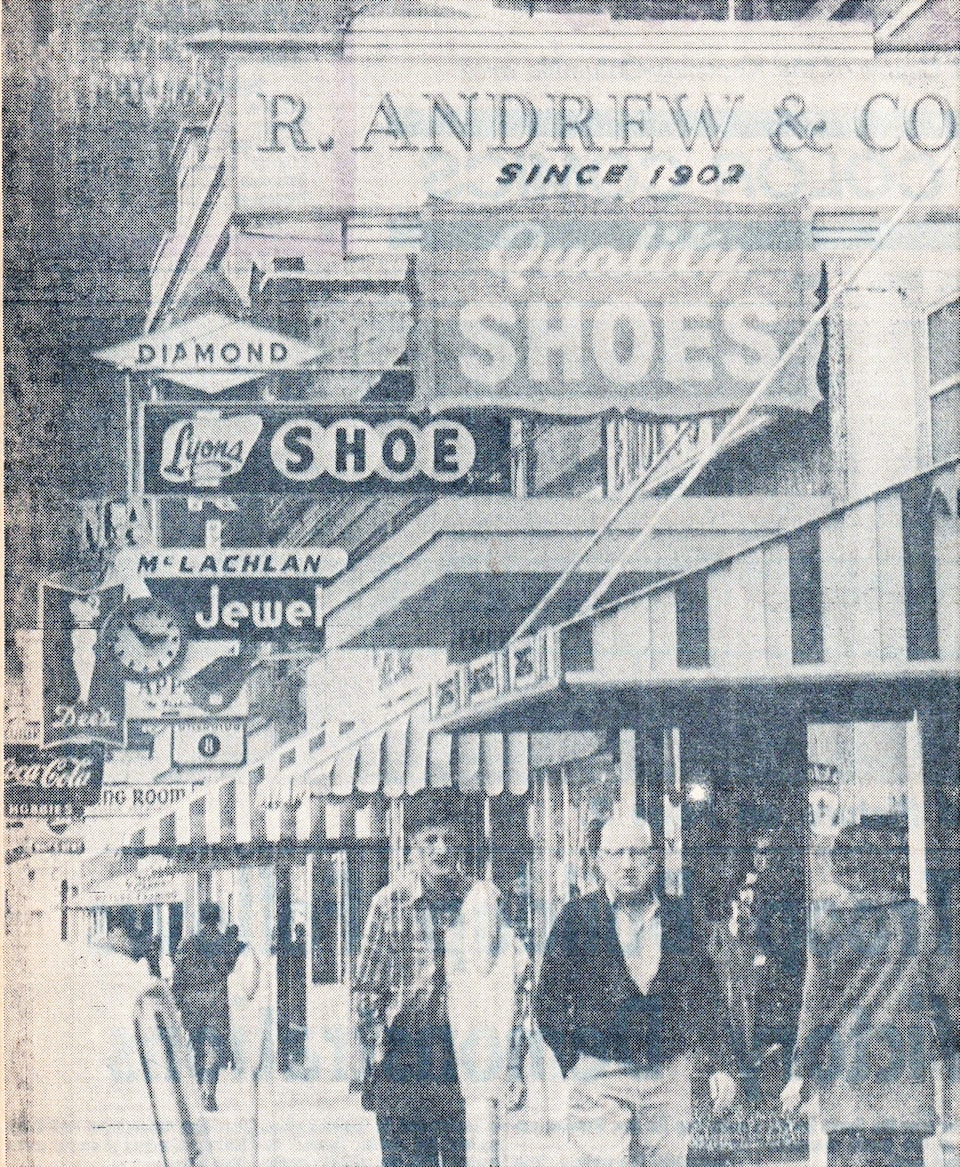Greg Scott
Dateline: April 5, 1969
A central core redevelopment plan for Nelson’s downtown area is gathering steam. The proposed plan, originally a project of the Chamber of Commerce, entails a study of the whole of Nelson’s core and its allied problems. A steering committee, composed of merchants, architects and members of the news media, has studied the re-development situation and has proposed a several stage plan to implement the ambitious re-development.
They envision a mall on Baker Street, with the avenue closed to cars, and trees and greenery planted along the street. But the first stage calls for the erection of canopies, covering the sidewalk, and the introduction of uniform store signs on the canopies. Under each canopy would be a radiant heater. These would replace the present jumble of odd-shaped signs, often thrusting over the sidewalk at different angles, making them unreadable. Preliminary cost estimates for the canopy stage put the price at $66.50 a foot, thus the average block would cost a total of $21,000. ($21,000 in 1969 is about $147,109 today)
Dateline: April 7, 1969
Sale of the Hudson’s Bay Store, established in Nelson 77 years ago, was announced Saturday. Three medium-sized stores in Nelson, Kimberley and Powell River have been sold to Fields Stores Ltd of Vancouver for “reasons of administration convenience.” Department store service will be continued in the three communities. The manager and 30 staff members will continue in their various capacities with no change in charge accounts or other phases of the store operation. The store has been on its present site since 1900. The first store, built in 1892, was on the same intersection, Baker and Stanley Streets, at 395 Baker.
Dateline: April 18, 1969
A new government building, housing all departments of the provincial government, will be built in Nelson, Provincial Secretary Wesley D. Black, MLA for Nelson-Creston, announced Friday. The new building, which will house government departments and employees now scattered throughout the city, is in the preliminary planning stages. The site is the land beside the Courthouse and stretching around in an “L” behind the Courthouse along Stanley Street. The new building will necessitate the tearing down of the city jail and police station but the present courthouse, which contains some government departments, will be retained. Mr. Black speculated that perhaps the Cenotaph could be erected on the front lawn of the building.
Dateline: April 24, 1969
Hundreds of people were evacuated and hundreds more were stranded Wednesday in downtown Trail buildings and on rooftops when Trail Creek burst its banks, sending a torrent of water raging through the lower city. City police, firemen, RCMP, civil defense workers, and hundreds of resident volunteers formed a task force to evacuate people from homes and businesses, but many were trapped inside.
Flood workers, some wearing scuba gear, carried people to safety. Others were boated to safety. Police closed all roads leading into the city centre. The flood, which began at 3 p.m., destroyed hundreds of thousands of dollars in property and merchandise in downtown stores and nearby homes. RCMP dynamited a section of the Columbia River retaining wall in a parking lot near the Cominco Arena to allow rising flood waters to drain off into the Columbia River which flows past the city.
The Columbia itself is not in danger of flooding. Trail Creek, however, fed by melting snow and heavy rains, is still rising. The torrent rose three feet between 4 and 5 p.m. and rose another foot-and-a-half between 8 p.m. and 9 p.m. The heavy rainstorm was accompanied by one of the most spectacular electrical storms ever seen in this area.
Dateline: April 26, 1969
The cost to put a severely modified Lakeside Park swimming pool back into operation would be about $10,000, a local architectural firm says. Architect D.P. Fairbank inspected the pool at the request of the Nelson Rotary Club and in his report to the club, fixes repair costs at an estimated $10,300. The main problem, the report says, is the undermining of pool walls and buttresses by the combinations of high water and leakage from the pool. The Rotary Club voted Friday to raise $4,000 this year to provide a heating system for the pool if the city will repair the pool for use this summer. ($10,300 equals approximately $72,000 today)
